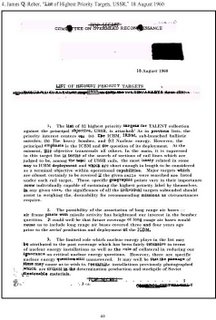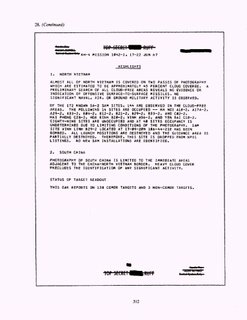Corona
CORONA is the name for the first operational space photo reconnaissance satellite. President Dwight David Eisenhower approved the project in Febuary 1958. The project was conceived to take pictures in space of the Soviet Bloc countries and de-orbit the photographic film for processing and exploitation.
As a result of the unexpected Japanese attack on Pearl Harbor in 1941, government officials looked to reorganize the American system of intelligence so as to ensure that the country never again be surprised by the actions of a foreign power. Members of the War Department and the Office of Scientific Research and Development agreed that the establishment of a private "think tank" would help produce more efficient intelligence gathering because such an organization could bridge the gap between recent scientific research and military strategy. Formed in December 1945, Project RAND (composed of scientists, engineers, mathematicians, and psychologists) soon began offering advice on how the government could better scrutinize the actions of its potential enemies. Aware that the U.S. implemented U-2 spy plane missions over Soviet territory between 1955 and 1958 to learn more about the country's military capabilities, RAND nonetheless recommended a different type of investigation - a man-made satellite that would take photographs from space. Unnerved by the Soviet launch of their own artificial satellite Sputnik in October 1957, President Eisenhower authorized the C.I.A. to secretly develop spy satellites to protect the interests of the United States both at home and abroad.
Recent technological advances such as radar, computers, and rocket engine design, in addition to the fear that the launch of Sputnik might signal a new period of Soviet scientific supremacy over the U.S., prompted the government to act quickly in the creation of a satellite reconnaissance system. The centerpiece of the effort, CORONA, soon revolutionized the art of assembling intelligence. Between 1959 and 1972, the government launched 145 CORONA satellites aimed at uncovering the essential military secrets of the Soviet Union and other potentially hostile foreign nations. During these 13 years, the CORONA satellites took pictures of military targets and returned the exposed film back to Earth in reinforced capsules, providing American leaders with essential information otherwise unobtainable. For instance, owing to photos retrieved from CORONA, the U.S. military determined that whereas the "missile gap" proposed by American experts did in fact exist, it actually favored the United States, not the Soviet Union.

Since the first successful launch of a CORONA satellite returned more photos of the Soviet Union than the 24 combined U-2 spy missions, satellite reconnaissance rapidly occupied an essential position in the determination of U.S. foreign policy towards cold war adversaries like the Soviet Union. Rather than being forced to make vague predictions about the military strength of other nations, American leaders used the data retrieved from satellites to form specific strategy initiatives. All in all, CORONA and the subsequent satellite reconnaissance systems served as the foundation for US space policy during the Cold War. By eliminating the guesswork regarding the military arsenals of nations around the world, during an era when the threat for nuclear conflict loomed large, the American satellite program actually served as a deterrent against the outbreak of war.
President Clinton signed an Executive Order on 22 February 1995, directing the declassification of intelligence imagery acquired by the first generation of U.S. photo-reconnaissance satellites; the systems code-named CORONA, ARGON and LANYARD. The order provides for the declassification of more than 860,000 images of the Earth's surface, collected between 1960 and 1972.


Early imagery collections were driven, in part, by the need to confirm purported developments in Soviet strategic missile capabilities. Worldwide photographic coverage was also used to produce maps and charts for the Department of Defense and other U.S. Government mapping programs. A speech made on 24 February 1995 by Admiral William O. Studeman, Acting Director of Central Intelligence Agency (CIA), recounts some of the important achievements of the historical satellite imagery reconnaissance programs.
The Corona vehicle was launched by a THOR booster and used the AGENA spacecraft as the upper stage. While in orbit, Corona took photographs with a constant rotating stereo panoramic camera system and loaded the exposed photographic film into recovery vehicles. The vehicles were de-orbited and recovered by Air Force C-119 aircraft while floating to earth on a parachute.
Some of the Corona project information has appeared to have been magiclly re-classified in the past few years. The Corona program was the first spaceborne imaging system that provided stereo-optical views of the earth. A target could be photographed from space with resolution down to five feet. Thats from space folks without the aid of any digital components. This was a film based system. Pretty amazing if you ask me.
As a result of the unexpected Japanese attack on Pearl Harbor in 1941, government officials looked to reorganize the American system of intelligence so as to ensure that the country never again be surprised by the actions of a foreign power. Members of the War Department and the Office of Scientific Research and Development agreed that the establishment of a private "think tank" would help produce more efficient intelligence gathering because such an organization could bridge the gap between recent scientific research and military strategy. Formed in December 1945, Project RAND (composed of scientists, engineers, mathematicians, and psychologists) soon began offering advice on how the government could better scrutinize the actions of its potential enemies. Aware that the U.S. implemented U-2 spy plane missions over Soviet territory between 1955 and 1958 to learn more about the country's military capabilities, RAND nonetheless recommended a different type of investigation - a man-made satellite that would take photographs from space. Unnerved by the Soviet launch of their own artificial satellite Sputnik in October 1957, President Eisenhower authorized the C.I.A. to secretly develop spy satellites to protect the interests of the United States both at home and abroad.
Recent technological advances such as radar, computers, and rocket engine design, in addition to the fear that the launch of Sputnik might signal a new period of Soviet scientific supremacy over the U.S., prompted the government to act quickly in the creation of a satellite reconnaissance system. The centerpiece of the effort, CORONA, soon revolutionized the art of assembling intelligence. Between 1959 and 1972, the government launched 145 CORONA satellites aimed at uncovering the essential military secrets of the Soviet Union and other potentially hostile foreign nations. During these 13 years, the CORONA satellites took pictures of military targets and returned the exposed film back to Earth in reinforced capsules, providing American leaders with essential information otherwise unobtainable. For instance, owing to photos retrieved from CORONA, the U.S. military determined that whereas the "missile gap" proposed by American experts did in fact exist, it actually favored the United States, not the Soviet Union.

Since the first successful launch of a CORONA satellite returned more photos of the Soviet Union than the 24 combined U-2 spy missions, satellite reconnaissance rapidly occupied an essential position in the determination of U.S. foreign policy towards cold war adversaries like the Soviet Union. Rather than being forced to make vague predictions about the military strength of other nations, American leaders used the data retrieved from satellites to form specific strategy initiatives. All in all, CORONA and the subsequent satellite reconnaissance systems served as the foundation for US space policy during the Cold War. By eliminating the guesswork regarding the military arsenals of nations around the world, during an era when the threat for nuclear conflict loomed large, the American satellite program actually served as a deterrent against the outbreak of war.
President Clinton signed an Executive Order on 22 February 1995, directing the declassification of intelligence imagery acquired by the first generation of U.S. photo-reconnaissance satellites; the systems code-named CORONA, ARGON and LANYARD. The order provides for the declassification of more than 860,000 images of the Earth's surface, collected between 1960 and 1972.


Early imagery collections were driven, in part, by the need to confirm purported developments in Soviet strategic missile capabilities. Worldwide photographic coverage was also used to produce maps and charts for the Department of Defense and other U.S. Government mapping programs. A speech made on 24 February 1995 by Admiral William O. Studeman, Acting Director of Central Intelligence Agency (CIA), recounts some of the important achievements of the historical satellite imagery reconnaissance programs.
The Corona vehicle was launched by a THOR booster and used the AGENA spacecraft as the upper stage. While in orbit, Corona took photographs with a constant rotating stereo panoramic camera system and loaded the exposed photographic film into recovery vehicles. The vehicles were de-orbited and recovered by Air Force C-119 aircraft while floating to earth on a parachute.
Some of the Corona project information has appeared to have been magiclly re-classified in the past few years. The Corona program was the first spaceborne imaging system that provided stereo-optical views of the earth. A target could be photographed from space with resolution down to five feet. Thats from space folks without the aid of any digital components. This was a film based system. Pretty amazing if you ask me.


5 Comments:
That was quite a fascinating read sir. Thanks for the science/history lesson.
That's what made the U.S. the world's supreme power, its incredible scientific/technological a ability above and beyond other nations.
Unfortunately, we developed the nuke and other technologies which shall come back to haunt us through terrorism and environmental destruction.
Besides, as impressive as CORONA was, I'm sure space aliens were laffing then at our "primitive" technology.
I'm not surprised that a film-based system did better than digital. Digital resolution blows.
luke, you are correct. its been a long time since i have seen an actual FILM image that I forget how good film can be. I found a nice CIA film on the corona project that is one of the reclassified items. its wrap up of the project and it interviews all the key players. The undercurrent of this CIA film is they all had mixed feelings about the project. Although it was a success everyone in the film seems to have a "I hate what we have done" tone to them. They also speak of a return from space that went horribly wrong and the cover story that went with it. Amazing stuff. and its all a secret once again. Thanks to the current administations BOG down with the FOIA.
Scotty, great read, I learned a lot...
now I wonder why "some of the Corona project information has appeared to have been magiclly re-classified in the past few years"?
Actually, I'm not surprised. ;-)
Digital photography like digital music can be amazing, but film and vinyl have a unique warmth and depth of their own imo.
The cheap Holga-lik cameras have created some beautiful photography...!
Off topic but I've only had one cup of coffee...
Blonde teen sex, sarı saçlı kızların pornoları ile sarışın porno instagram sex filmleri bir arada
Post a Comment
<< Home